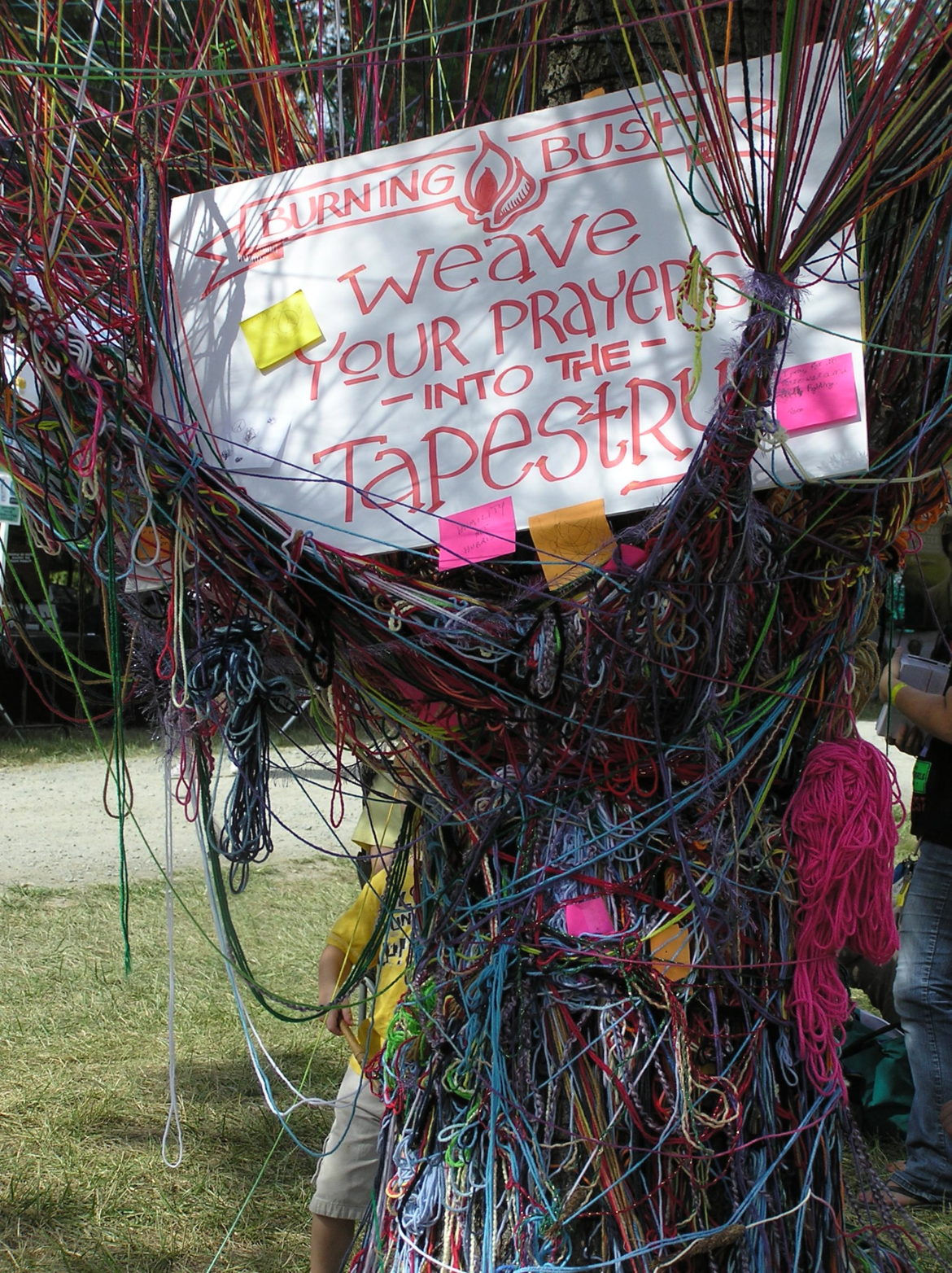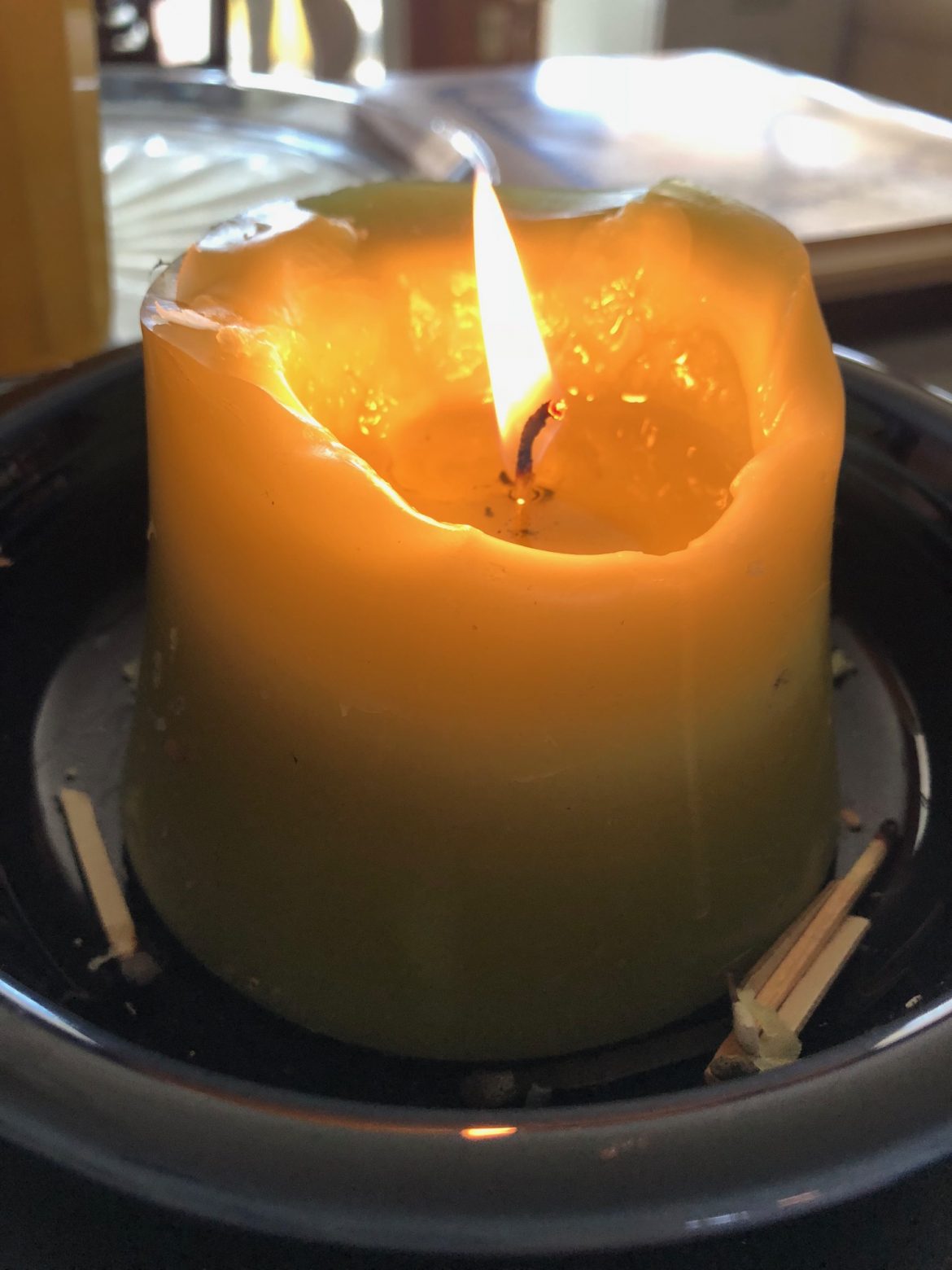by Christine Sine
This has been a challenging week for many of us and I find that the weight of watching Hurricane Michael advance, reading about the growing impact of climate change around the world, and the increasing vitriol from those on both the right and the left here in the U.S., is overwhelming.
At a time like this I find myself reaching for prayers and psalms to strengthen me. This time it was Psalm 86. I read it over several times, relishing the words written millennia ago. They remind me of the constancy of our God and as often happens, today too, out of a time of deep prayer and reflection God spoke to me.
First I was reminded of the image above – a powerful image from one of the Wild Goose Festivals I attended many years ago.
Then as I reflected on the image, my words too were crafted into prayer and praise.
God almighty, creator of the universe
Holy and righteous One, loving and caring One
Into your hands I commit my life.
My body, my soul and my spirit belong to you.
Guide me to the wholeness hidden deep within,
The light in dark and broken places
That flickers and shines with hope and promise of renewal.
God ever present, Architect of all that is, all that was and all that will be,
Faithful and true One, gracious and merciful One,
Weave the wonder of your love
Into the tapestry of my life.
I will stir the dawn with praise and thanksgiving.
I will brighten the day with joyful shouts.
I will delight in your eternal presence.
Your greatness is beyond compare.
Your truth is a canopy in the heavens.
Your mercy stands firm around the earth.
Holy One, Sacred Three,
Your glory fills the universe,
I give myself to you.
I will praise your name for ever and ever.
By Rodney Marsh —
Down Under it is spring-time and here in South West Western Australia change is in the air, sea and land. The days are lengthening, the Humpbacks and Southern Right whales heading home to Antarctica and the land is bursting into bloom. The treasures found in this dry, infertile, ancient land are revealed at this time of year. The land hosts a diversity, uniqueness and richness in its unique plants. The area is the only ‘biological hotspot’ in Australia. A nearby National Park has 1800 different plant species and 80% of plant species in Western Australia are endemic (only found here).
God’s book of nature has much to teach us. For a short time, local ephemeral native orchids flower and then are gone. Some are pictured below. Orchid flowers are tiny, fragile, delicate and beautiful. Jesus drew this lesson from such natural beauty, “….look at the wildflowers. They don’t fuss with their appearance—but have you ever seen colour and design quite like it? The ten best-dressed men and women in the country look shabby alongside them. If God gives such attention to the wildflowers, most of them never even seen, don’t you think he’ll attend to you, take pride in you, do his best for you?”
 Posted alongside a photo of a local orchid and following the death of a young person, here is what my Pastor, Rev Corina van Oostende wrote last Sunday…. “We are fragile beings. Probably more vulnerable than these orchids. We are so much more complex, and need so many different things to thrive, so many things to stay health, and so many things when we fall ill. All these plants need is some poor soil, some water and sunshine, to grow and bloom and go dormant, in a life cycle that can go on for 50 years or more. Their thin stems bear the weight of three flowers. Yet come with and weather they don’t break. Our bones can break, and so can our spirit. In times of feeling fragile, vulnerable, brittle, some words of Psalm 139 may bring strength. ‘You have looked deep into my heart, Lord, and you know all about me….. You are the one who put me together inside my mother’s body, and I praise you because of the wonderful way you created me. Everything you do is marvelous! Of this I have no doubt.’”
Posted alongside a photo of a local orchid and following the death of a young person, here is what my Pastor, Rev Corina van Oostende wrote last Sunday…. “We are fragile beings. Probably more vulnerable than these orchids. We are so much more complex, and need so many different things to thrive, so many things to stay health, and so many things when we fall ill. All these plants need is some poor soil, some water and sunshine, to grow and bloom and go dormant, in a life cycle that can go on for 50 years or more. Their thin stems bear the weight of three flowers. Yet come with and weather they don’t break. Our bones can break, and so can our spirit. In times of feeling fragile, vulnerable, brittle, some words of Psalm 139 may bring strength. ‘You have looked deep into my heart, Lord, and you know all about me….. You are the one who put me together inside my mother’s body, and I praise you because of the wonderful way you created me. Everything you do is marvelous! Of this I have no doubt.’”
If you’re curious to see more wonderful photos of many of the Western Australian native orchids flowering at this time of year, click here.
By Ana Lisa de Jong —
MADE FOR HIM
He made me not for me
and not for you, but for himself.
He made me delicate, complex,
unique.
In that where I see imperfect, flawed,
and inadequate;
he sees the beauty of his intent,
the potential of his design,
the splendid intricacy of his plan
come to life.
I was made for him and not for you,
or even myself.
For his pleasure
I have been breathed into existence.
That just for a moment of time,
I might sing the song he’s given.
That my voice and heart might inhabit the role
he’s signaled as mine.
The answer to our inadequacies
is in remembering why.
When we know the answer there is no question.
For we know where our worth and purpose lies.
Our protests die on our lips
and we rest in the peace of his providence.
Yes, I was made for you God,
nothing else.
Establish me entirely as your own,
for therein is the place I find myself.
by Christine Sine
Tom and I have just returned from celebrating Canadian Thanksgiving with good friends in Tsawwassen B.C. It was a wonderful weekend of feasting, fellowship and reminiscing.
Gratitude is the Right Place to Start
It was an enriching start to my preparation for the coming season of Advent and Christmas which I love to begin with a week of gratitude and thanksgiving. Saturday night we ate turkey, stuffing and gravy with a rich assortment of vegetables, then finished with a scrumptious dessert. I ate until I thought I would never be able to eat again. We wrote words of gratitude on leaves around the candle then we shared them and reflected on the delight of the abundance God had blessed us with. It was a feast of a different sort that I think will keep me satisfied for much longer than the food. Maybe I need more than a week of gratitude I thought. Maybe a whole month will help.
What I noticed was that the food did not satisfy for long. By Sunday morning I was hungry again and relished the scrambled eggs and muffins for breakfast.
Hunger for The Bread of Heaven
On Sunday we went to church where the pastor began his sermon with the words “Are you hungry?” And believe it or not my answer was yes. My body was ready for another meal. Then we came to communion, where he talked about the bread that comes down from heaven, and the words in John 6:35 I am the bread that gives life. If you come to My table and eat, you will never go hungry. Believe in Me, and you will never go thirsty.
As we drove home to Seattle that afternoon I found myself reflecting on these words. As I start to prepare for Advent and Christmas what am I hungry for? Am I hungry for things that only satisfy for a few hours or days or am I hungry for the bread of life that will satisfy me forever? To be honest it’s probably a bit of both but how do I make the choices to focus predominantly on that which will sustain me through eternity?
As I reflected on this, the Christmas story was replayed in my mind.
I thought of Mary and Joseph whose hunger to serve God must have made them vulnerable to misunderstanding, even possibly contempt from their friends and family. They were willing to put their lives on the line because they believed God had called them to be family to the coming Messiah.
I thought too of the wise men whose hunger for a glimpse of the Messiah had made them drop everything to follow a star, a rather uncertain guide for their hard and probably perilous long journey. They too put their lives on the line – I suspect they had many scary adventures on their journey but their hunger for the bread of life endured.
Then my thoughts went to the priests and religious leaders in Jerusalem. They knew where the Messiah was supposed to be born and they listened to the wise men tell of their quest to find this Messiah and worship him. What puzzles me is why they too did not have the hunger in their hearts to follow the wise men to Bethlehem. Had their hunger for the bread of life been sated by wealth and power? Were they afraid of the consequences if they went against their often harsh Roman rulers? Or had they lost their appetite through disillusionment at the slowness of God’s fulfillment?
What will it take for me to hunger for the bread of heaven revealed in the birth of Jesus Christ… against all odds, in the coming months?
What does my heart hunger for as I prepare for Christmas this year? Like Mary and Joseph, I must believe in the truth of God’s coming Messiah with all my heart and be willing to put everything else aside to come and worship. That I know means taking time to slow down and listen. Christ has already been revealed to me in so many ways yet I still know he wants to be rebirthed in my life. How will I keep that hunger alive as I move towards Christmas?
What am I willing to risk to see my hunger satisfied? The wise men risked everything on their journey. They wanted to be changed by their encounter with the Messiah and they did not give up until they knelt before the Christ child and worshipped him. As I look ahead I know it will be easy for me to get distracted or to take my encounter with Jesus for granted. After all I have been a follower of this Christ child for a long time. But there is a hunger in my heart for something new and I pray that hunger will endure.
What about you? What does your heart hunger for as you look towards Christmas? Prayerfully consider this. Write down what you sense God is saying to you. What could you do now to make this possible?
By Lilly Lewin
This season has been a hard one for many of us. There is conflict and pain and misunderstanding. There are floods, and earthquakes and a tsunami. There is famine and poverty here at home, and abroad. There are votes that count, and votes we cannot control. All of this gives me pause and can lead me down the dark road of despair if I’m not careful. A good friend reminded me of the Beatitudes this morning. And she reminded me of the great practice of lament. We all need to be honest with our pain and our grief. We need to express it in order to heal. My good friend Mark Scandrette created a fantastic resource on living out the Beatitudes called The Ninefold Path. Each Beatitude has a prayer posture and a BEAT, or practice, to live out. There is a great resource guide you can do on your own or with a small group too. But today, in the midst of the pain and grief of our world, I want to offer Mark’s Beat #2… on The Way of Lament, Blessed are those who Mourn . Watch it below and do the prayer posture. Allow the God of love and hope to bring you comfort. Allow the peace of Jesus to flow over you! And Light a candle today and remember that the darkness cannot overcome the Light.
By John Birch ––
I see a tendency in people these days, not just Christians, to over-complicate their lives, and I include myself in this. To fill each moment of the day with ‘stuff’, get involved in far too many things, feel guilty about having ‘down time’ and chilling out when I could be doing so much more, afraid of wasting time.
The danger in doing this is that each day becomes way too focused on ‘me’ and leads eventually to burn out. I’m so busy doing all this stuff that I’m getting less aware of the world around me, less aware of how my friends and neighbours are, less focussed on family and even my own well-being. I’m in some way trying to convince myself and God that I’m making the best use of each day of my life. And I’m obviously not!
God does not want us burning out.
God wants us to simply ‘be’. God wants us, in our normal working lives to be listening, to be aware of the world around us, to be willing to help where help is needed, be willing to share words of comfort or faith where appropriate, to be strong, to be focusing on being rather than on me, to become that which God wants us to be.
Grant us, Lord,
listening ears,
eyes that see,
willing hands,
humble hearts,
words that speak,
faith that stands.
Help us, Lord
to be everything
that we should be.
By Tom Sine —
I enjoyed offering a Futures/Creativity Workshop at First Christian Reformed Church in Grand Rapids last March.
As I was leaving the Workshop Pastor Randy Buursma shared “that First CRC Church has always been a “two-fer” congregation.” I asked “what does that mean?”
Randy said “several years ago when I first came to the church being a ‘two-fer’ meant members attending Sunday morning and Sunday night.” He added, “Now he said it means members attending twice a month.”
Randy’s experience is not unique. I am finding over the past decade more and established evangelical and mainline churches have also been experiencing a sharp decline in attendance. How do we fix the drip?
A couple planting a new church here in Seattle started with meeting for worship twice a month to make it easier to get started.
As American Christians become more affluent not only is their attendance declining. So is their annual giving.
According the State of Church Giving 2015. Sampling 11 of the major American protestant denominations their members gave 3.02% of their income in 1968 and only 2.17% in 2015. How do we fix the drip?
Even more concerning is these members and their congregations gave even a smaller share to neighbors in need. In 1968 these churches gave 64% of their giving to benevolence as compared to only 34% in 2015. How do we fix the drip?
Research show members in established evangelical and mainline congregations also have less time to volunteer to reach out to those in need. How do we fix the drip?
How do we fix the drip in established churches? How long can reduced participation and giving continue in evangelical and mainline churches before the vitality of congregations disappear?
For this blog I suggest that some of us who are older can help fix the drip before it begins by supporting Gen Next as they launch!
Young leaders who are planting new churches and seeking to make a difference are often facing even more daunting challenges than established churches.
Recently we were fortunate to have JR Woodward, from V3 Church Planting Network, meet with church planters in our home. He provided some very helpful insights, based on discipleship models in early Methodism, to enable members in these new plants to be better stewards of both their time and money as followers of Jesus.
I am encouraged to find that many older leaders, in our established churches, want to find ways to support the young starting these new church plants. However, I find that few of them recognize how much more difficult for this generation to launch economically than when many of us got started.
First, millennials are saddled with much higher school debt than older generations. School debt is averaging almost $40,000 for recent college grads. Some seminary grads I have met recently, that want to plant churches, are carrying over $100,000 in college and seminary debt.
Second, housing costs take a much higher percentage of total income for millennials than they ever did for Boomers or Xers.
Christine and I are enjoying experimenting with one alternative housing model to help a new generation launch, plant churches and make a little difference in times like these.
Over 20 years ago Christine and I bought an old house built in 1910 here in Seattle that was divided into three separate flats to experiment in intergenerational living we call the Mustard Seed House.
We offer reduced rent. Every week we share a meal, checkin time and prayer once a week and seek to be mutually supportive. We also garden together once a month, enjoy the produce and enjoy sharing in hospitality with friends as well.
Our top floor is a three bedroom flat. Trevor and Hilary and their two young sons live there. They are very invested in planting the new church I mentioned earlier with Converge.
Christine and I live in the middle floor which is a two bedroom apartment with our pup Goldie.
Dan & Lisa live in our basement unit which is a one bedroom flat. They are also involved in the church plant with Trevor and Hilary though they are employed elsewhere. We enjoy learning from them.
Finally, Luke, a recent grad from Seattle School of Theology and Psychology, also lives in a separate unit in the basement that we call our “monk’s cell” that has it’s own bath. Luke is an active member at an ElLCA innovative congregation that also attracts a lot of younger Christians here in Seattle called Church of the Apostles.
One way, those of us who are older followers of Jesus, can both reduce the drip and increase our investment in growing the church is to open our homes to a new generation of changemakers in times like these!
We would be happy to email you a copy of our community contract at Mustard Seed House and answer any of your good questions.
We would also be interested in any ideas you have come up with to SUPPORT A NEW GEN OR REDUCE THE DRIP IN CHURCH PARTICIPATION IN TIMES LIKE THESE!
twsine@gmail.com
As an Amazon Associate, I receive a small amount for purchases made through appropriate links.
Thank you for supporting Godspace in this way.
When referencing or quoting Godspace Light, please be sure to include the Author (Christine Sine unless otherwise noted), the Title of the article or resource, the Source link where appropriate, and ©Godspacelight.com. Thank you!







